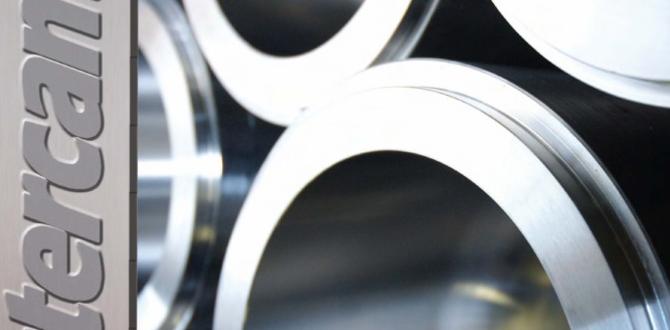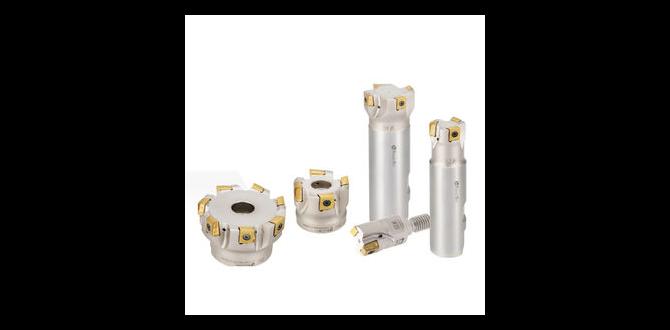Summary: A TiAlN ball nose end mill is crucial for titanium profiling because its PVD coating withstands high temperatures and friction, allowing for cleaner cuts and longer tool life. It’s the go-to choice for effectively and efficiently machining titanium alloys like Grade 5.
Hey there, fellow makers! Daniel Bates here from Lathe Hub. If you’ve ever tried to machine titanium, especially for those intricate contoured shapes, you know it can be a real challenge. Titanium is tough, sticky, and loves to build up heat. This often leads to dull tools, rough finishes, and a lot of frustration. But don’t worry! There’s a secret weapon that can make profiling titanium so much easier: the TiAlN ball nose end mill. We’re going to dive into why this specific tool is so important and how it can transform your titanium machining projects.
Why Titanium is a Machining Headache
Before we talk about the solution, let’s quickly touch on why titanium gives machinists a run for their money. Titanium alloys, like the very common Grade 5 (Ti-6Al-4V), are known for their:
High Strength-to-Weight Ratio: Great for aerospace and medical implants, but means they’re hard to cut.
Low Thermal Conductivity: Heat generated during cutting doesn’t dissipate well, leading to tool overheating and material softening right at the cutting edge.
Tendency to Weld to the Tool: This “built-up edge” (BUE) can cause poor surface finish and premature tool failure.
Abrasiveness: Can wear down conventional tooling very quickly.
These properties mean that using the wrong cutting tool for titanium profiling is like bringing a butter knife to a sword fight – you’re unlikely to get the results you need.
What is a Ball Nose End Mill?
A ball nose end mill is a type of cutting tool used in milling operations. Unlike flat-bottomed end mills, the cutting tip of a ball nose end mill is hemispherical, or “ball-shaped.” This shape is perfect for creating curved surfaces, fillets, and complex 3D contours. When you’re “profiling” – which essentially means cutting around the perimeter or creating a shaped cavity – a ball nose end mill offers smooth, flowing cuts.
Introducing the TiAlN Coating: The Magic Ingredient
Now, let’s talk about the “TiAlN” part. This refers to a Titanium Aluminum Nitride coating applied to the surface of the end mill using Physical Vapor Deposition (PVD). This coating is a game-changer for machining demanding materials like titanium. Here’s why:
Extreme Hardness: TiAlN is incredibly hard, which resists abrasive wear and keeps the cutting edge sharp for longer.
High-Temperature Resistance: This is critical for titanium. TiAlN coatings form a protective aluminum oxide layer at high temperatures, which further increases hardness and prevents the coating from breaking down when the tool gets hot. This is key to preventing that dreaded welding or built-up edge.
Reduced Friction: The smooth, slick surface of the TiAlN coating helps chips flow away more easily and reduces the friction between the tool and the workpiece. Less friction means less heat generation.
Why TiAlN is Essential for Titanium Profiling
When you combine the ball nose geometry with the TiAlN coating, you get a tool specifically engineered for the challenges of titanium. Here’s why it’s the best choice for profiling:
1. Handles High Cutting Temperatures: Titanium generates a lot of heat during machining. The TiAlN coating is excellent at resisting these elevated temperatures, preventing the tool from softening and wearing out quickly. This allows you to maintain consistent cutting parameters and get a good finish.
2. Minimizes Built-Up Edge (BUE): The slick TiAlN surface reduces the tendency for titanium to stick to the cutting edge. This leads to cleaner cuts, better surface finishes, and stops chips from gumming up the tool.
3. Improved Tool Life: Because the tool stays sharper for longer and resists wear so effectively, you’ll get significantly more parts machined before needing to replace the end mill. This translates to lower costs and less downtime.
4. Superior Surface Finish: Reduced BUE and consistent cutting lead to smoother, more accurate contoured surfaces on your titanium parts. This is often crucial for components used in aerospace or medical applications.
5. Efficient Material Removal: While titanium requires slower speeds and feeds than softer metals, a TiAlN ball nose end mill allows you to achieve these parameters effectively, ensuring you can still remove material efficiently and complete your profiling tasks.
Choosing the Right TiAlN Ball Nose End Mill for Titanium Grade 5
Not all TiAlN ball nose end mills are created equal, especially when you’re targeting a specific material like Titanium Grade 5. Here’s what to look for:
Key Features to Consider:
Carbide Grade: Look for high-quality carbide, typically Tungsten Carbide (WC). This provides a strong, rigid base for the TiAlN coating. Sub-micron carbide grades offer even better strength and wear resistance.
Number of Flutes: For titanium profiling, 2 or 3 flutes are often recommended.
2-Flute: Offers more chip clearance, which is very important for sticky materials like titanium. This helps prevent chip recutting and overheating.
3-Flute: Can sometimes offer a good balance between rigidity and chip evacuation, but 2-flutes are generally preferred for titanium.
Coating: Ensure it’s a PVD TiAlN coating designed for high-temperature alloys. Some manufacturers offer specialized coatings that are optimized further for titanium.
Helix Angle: A moderate helix angle (around 30 degrees) is common. Very high helix angles can be too flexible, while very low angles might not provide good chip evacuation.
Corner Radius/Ball Nose: This should match your design requirements precisely. The radius determines the smoothness of the internal corners you can achieve.
Specific Design for Titanium: Some tool manufacturers design their end mills with specific features for machining difficult materials like titanium. This might include specialized flute geometry or optimized rake angles.
Tool Diameter: Choose a diameter that’s appropriate for your profiling operation. Smaller diameters are good for intricate details, while larger ones are for heavier roughing passes.
Understanding the “35 Degree” Specification
You might see “TiAlN ball nose end mill 35 degree for titanium grade 5 for profiling” in product descriptions.
What does the “35 degree” refer to? Often, this refers to the helix angle of the end mill. A 35-degree helix angle is a good general-purpose choice that provides a balance between cutting performance, chip evacuation, and tool rigidity, making it suitable for profiling many materials, including titanium.
Material Considerations: Titanium Grade 5
When using your TiAlN ball nose end mill, remember you’re working with Titanium Grade 5 (Ti-6Al-4V). This alloy is very common due to its excellent balance of properties but presents the machining challenges we discussed. The TiAlN coating is particularly effective against the high heat and tendency for BUE common with Grade 5.
Setup and Machining Best Practices
Using the right tool is only half the battle. Proper setup and machining practices are vital for success.
Key Setup Steps:
1. Rigid Workholding: Titanium is tough, and cutting forces are significant. Ensure your workpiece is held extremely securely. Use vises, clamps, or specialized fixturing that won’t flex or allow movement.
2. Rigid Machine Tool: A sturdy, well-maintained milling machine is essential. Any machine flex or vibration will negatively impact tool life and surface finish.
3. Secure Tool Holder: Use a high-quality, runout-free tool holder (like a shrink fit holder or a quality collet chuck) to ensure the end mill is held accurately and doesn’t wobble.
4. Proper Tool Length: Minimize the amount of the tool shank extending beyond the tool holder. The longer the tool sticks out, the more it can deflect, leading to inaccuracies and increased chatter.
Machining Parameters: The Sweet Spot
Finding the right speeds and feeds is critical. For titanium and a TiAlN ball nose end mill, you’ll generally be working with:
Spindle Speed (RPM): Relatively low. For a typical 1/2 inch diameter end mill, you might start in the range of 1000-3000 RPM, but this varies greatly with tool size, machine rigidity, and coolant.
Feed Rate (IPM or mm/min): Moderate to slow. This is where you engage the tool. A good starting point for depth of cut and chip load (the thickness of the material removed by each cutting edge) is crucial.
Depth of Cut (DOC): Often shallow. For both axial (down) and radial (sideways) cuts, it’s usually better to take lighter passes. This allows the TiAlN coating to do its job effectively without overloading the tool.
Coolant/Lubrication: Absolutely essential! A high-quality flood coolant or misting system is highly recommended. This helps to:
Cool the cutting zone, reducing heat buildup.
Lubricate the cut, reducing friction.
Flush away chips, preventing recutting.
Many machinists prefer specialized synthetic coolants or milling pastes designed for titanium machining. These often contain extreme pressure additives that are beneficial. For a great overview of machining coolants, check out resources from the National Association of Manufacturers (NAM) or reliable machining supplier guides.
Example Cutting Parameters (Starting Point for 1/2″ TiAlN Ball Nose End Mill on Titanium Grade 5):
This is a starting point and will need to be adjusted based on your specific machine, tool manufacturer recommendations, and the exact titanium alloy. Always start conservatively and increase parameters as confidence grows.
| Parameter | Value (Approximate) | Notes |
| :—————— | :—————— | :——————————————————————————————————- |
| Spindle Speed (RPM) | 1500 – 3000 | Lower end for roughing, higher for finishing. Consult tool manufacturer. |
| Feed Rate (IPM) | 10 – 30 | Adjust based on chip load. Aim for a light, consistent chip. |
| Axial DOC (in) | 0.050 – 0.100 | Light passes are key. |
| Radial DOC (in) | 0.020 – 0.050 | For profiling, this is the stepover. Smaller stepover for smoother finish. |
| Chip Load (in/flute)| 0.002 – 0.005 | Crucial for chip formation and tool pressure. |
| Coolant | Flood / Mist | Essential. Use a dedicated titanium machining fluid. |
Always refer to the specific recommendations from your tool manufacturer. They often provide detailed cutting data charts for various materials.
Benefits of Using a TiAlN Ball Nose End Mill for Titanium Profiling
Let’s recap why this tool is so great for your titanium projects:
Extended Tool Life: Get more parts out of each end mill.
Improved Surface Finishes: Achieve those smooth, contoured surfaces you need.
Reduced Machining Time: More efficient material removal and less downtime for tool changes.
Consistent Results: Dependable performance across multiple operations.
Handles Toughness: Minimizes risks associated with titanium’s inherent machining difficulties.
Cost-Effectiveness: While the initial tool cost might be slightly higher, the increased productivity and reduced scrap make it more economical in the long run.
When to Use Alternative Tooling (and why TiAlN is still king for titanium)
While TiAlN is the champion for titanium profiling, it’s good to know about other options and when they might be considered for other materials or very specific titanium operations:
Uncoated Carbide: Good for some softer steels or aluminum, but will rapidly wear out or gall on titanium without special geometry and very careful parameter management.
TiCN (Titanium Carbonitride): Harder than TiN, but doesn’t offer the same high-temperature resistance as TiAlN. Better for abrasive, lower-temperature machining in steels.
TiB2 (Titanium Diboride): Extremely hard and wear-resistant, offering excellent performance in abrasive materials like cast iron and composites. Can be effective on titanium but might be more brittle.
ZrCN (Zirconium Carbonitride): Offers good lubricity and wear resistance, often used in aluminum and plastics.
* DLC (Diamond-Like Carbon): Incredibly hard and low friction, fantastic for aluminum and composites. Can be used on some titanium alloys but might be overkill and more expensive.
For the distinct challenges of titanium profiling (high heat, tendency to gall), TiAlN remains the go-to coating for its balanced properties of hardness, high-temperature resistance, and friction reduction. Its ability to form that protective aluminum oxide layer at high temps is a critical advantage that other coatings simply don’t match for this application.
Frequently Asked Questions (FAQ)
What is TiAlN?
TiAlN stands for Titanium Aluminum Nitride. It’s a very hard, wear-resistant coating applied to cutting tools, often using a PVD (Physical Vapor Deposition) process. It’s excellent at high temperatures and reduces friction.
Why is a ball nose end mill good for titanium profiling?
The ball shape allows for smooth, contoured cuts, which is what “profiling” means for 3D shapes. When combined with a TiAlN coating, it can handle the high heat and sticky nature of titanium, preventing tool wear and buildup.
Can I use a TiAlN ball nose end mill on other metals like aluminum?
Yes, you can, but it might be overkill. TiAlN is great for titanium and other high-temperature alloys. For softer metals like aluminum, coatings like TiCN or even uncoated carbide or specific aluminum coatings might perform better and be more cost-effective. However, a TiAlN can still work if a variety of materials need to be machined with one tool.
What’s the difference between a 2-flute and a 3-flute TiAlN ball nose end mill for titanium?
For titanium, a 2-flute end mill is generally preferred. It offers better chip clearance, which is crucial for sticky materials like titanium. This helps prevent chips from getting stuck, reduces heat buildup, and minimizes chip recutting.
How do I know the right speeds and feeds to use?
Always start with the tool manufacturer’s recommended speeds and feeds. They’ll usually provide a chart for different materials, including titanium. Begin conservatively and adjust based on chip formation, sound, and surface finish. A good coolant is also essential.
Is TiAlN coating expensive?
Tools with TiAlN coatings are generally more expensive upfront than uncoated tools. However, the significantly increased tool life, improved performance, and better surface finish on difficult materials like titanium often make them more cost-effective in the long run.
Do I need special coolant for titanium machining with a TiAlN end mill?
Yes, high-quality coolant is critical. While some general-purpose coolants can work, using a synthetic coolant or mist designed specifically for machining difficult alloys like titanium is highly recommended. These fluids offer better lubrication and cooling, essential for preventing tool welding and ensuring good chip evacuation.
Conclusion
Machining titanium can feel daunting, but with the right tools, it becomes an achievable and rewarding process. The TiAlN ball nose end mill isn’t just a suggestion for titanium profiling; it’s an essential component for anyone looking to achieve clean, accurate, and efficient results when working with these challenging alloys.
By understanding why this tool is so effective – its heat resistance, its ability to minimize built-up edge, and its contribution to superior finishes and tool life – you’re well on your way to conquering titanium. Remember to pair your TiAlN ball nose end mill with rigid setups, appropriate machining parameters, and robust coolant systems.
So, next time you’re facing a titanium profiling project, reach for that TiAlN ball nose end mill. It’s your key to unlocking better performance, longer tool life, and beautiful finished parts. Happy machining, and keep creating!








